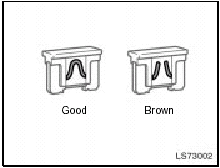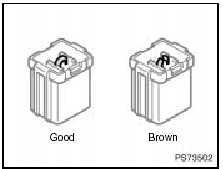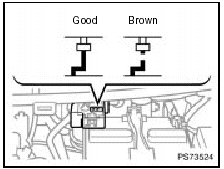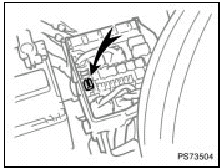 Toyota Yaris: Checking and replacing fuses
Toyota Yaris: Checking and replacing fuses

Type A

Type B

Type C

If the headlights or other electrical components do not work, check the fuses. If any of the fuses are blown, they must be replaced.
See “Fuse locations” for locations of the fuses.
Turn the ignition switch and inoperative component off. Pull the suspected fuse straight out and check it.
Determine which fuse may be causing the problem. The lid of the fuse box shows the name of the circuit for each fuse. See Section 8 for the functions controlled by each circuit.
Type A fuses can be pulled out by the pull-out tool. The location of the pull-out tool is shown in the illustration.
If you are not sure whether the fuse has blown, try replacing the suspected fuse with one that you know is good.
If the fuse has blown, push a new fuse into the clip.
Only install a fuse with the amperage rating designated on the fuse box lid.
If you do not have a spare fuse, in an emergency you can pull out the “A/C” fuse, which may be dispensable for normal driving, and use it if its amperage rating is the same.
If you cannot use one of the same amperage, use one that is lower, but as close to the rating as possible. If the amperage is lower than that specified, the fuse might blow out again but this does not indicate anything wrong. Be sure to get the correct fuse as soon as possible and return the substitute to its original clip.
It is a good idea to purchase a set of spare fuses and keep them in your vehicle for emergencies.
If the new fuse immediately blows out, there is a problem with the electrical system.
Have your Toyota dealer correct it as soon as possible.
CAUTION.
Never use a fuse with a higher amperage rating, or any other object, in place of a fuse. This may cause extensive damage and possibly a fire.
 Battery recharging precautions
Battery recharging precautions
During recharging, the battery is producing hydrogen gas.
Therefore, before recharging:
1. If recharging with the battery installed on the vehicle, be sure to disconnect
the ground cable.
2. B ...
 Adding washer fluid
Adding washer fluid
If any washer does not work or the low windshield washer fluid level warning
light comes on, the washer tank may be empty. Add washer fluid.
You may use plain water as washer fluid.
However, in ...
See also:
Foreword
This repair manual has been prepared to provide essential information on body
panel repair methods (including cutting and welding operations, but excluding painting)
for the TOYOTA YARIS.
Applica ...
Washing and waxing your Toyota
Washing your Toyota
Keep your vehicle clean by regular washing.
The following cases may cause weakness to the paint or corrosion to the body
and parts. Wash your vehicle as soon as possible.
...
Theft prevention labels (except Canada)
These labels are attached to the vehicle to reduce vehicle theft by facilitating the tracing and recovery of parts from stolen vehicles. Do not remove under penalty of law. ...
